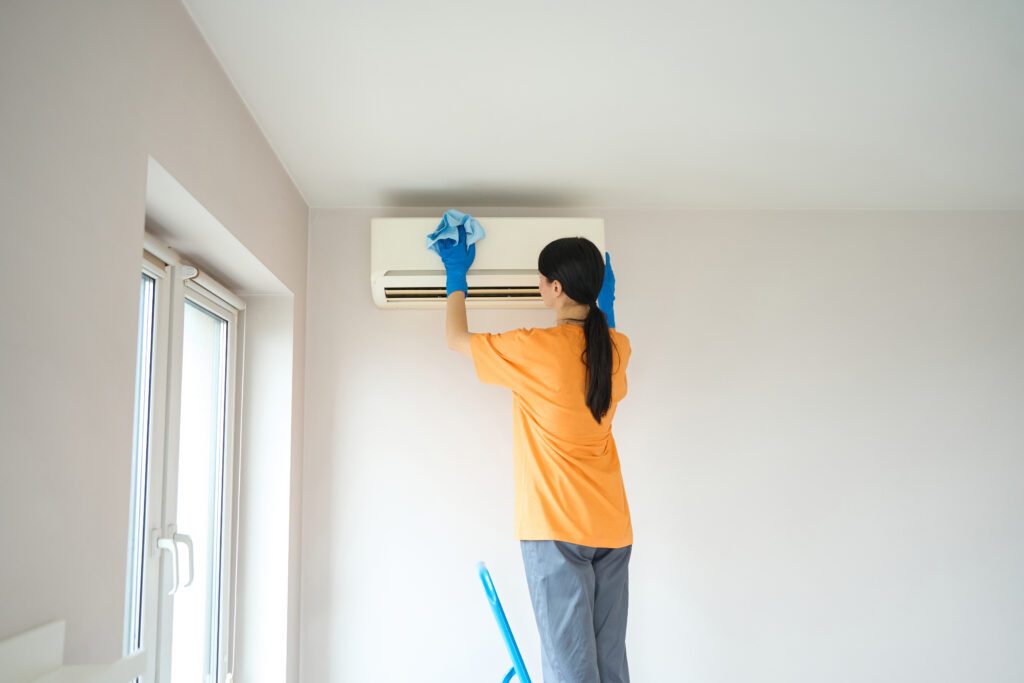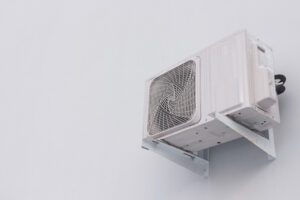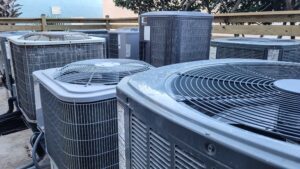With the arrival of spring, it’s time to start thinking about giving your air conditioner some much-needed attention. Regular maintenance and cleaning are essential to ensure optimal performance and prolong the lifespan of your cooling system. In this ultimate spring cleaning guide, we will explore the importance of regular air conditioner maintenance, provide steps to prepare and clean your unit, discuss post-cleaning maintenance, and highlight common mistakes to avoid. Let’s dive in!
Understanding the Importance of Regular Air Conditioner Maintenance
Regular air conditioner maintenance plays a crucial role in keeping your cooling system running smoothly. Neglecting maintenance can have adverse effects on both performance and longevity, resulting in higher energy bills, reduced cooling efficiency, and potential breakdowns.
When an air conditioner is not maintained, dust, dirt, and debris accumulate on the condenser coils and air filters. This accumulation restricts airflow, making the system work harder to cool your home. As a result, your energy consumption increases, leading to higher utility bills.
The Impact of Neglected Maintenance on Air Conditioner Performance
Neglected maintenance can severely impact the performance of your air conditioner. Clogged air filters and dirty coils make it difficult for the system to expel heat properly, causing the compressor to work harder and potentially overheat. This strain on the system leads to decreased cooling capacity and increased wear and tear on vital components, reducing its overall efficiency.
Inadequate cooling capacity not only affects your comfort but also forces the air conditioner to run for longer periods, further escalating energy costs. Additionally, neglected maintenance can increase the likelihood of breakdowns, leaving you without cooling during the hottest days of summer.
How Regular Cleaning Enhances the Lifespan of Your Air Conditioner
Regular cleaning is essential to maintain the longevity of your air conditioner. By removing dirt, dust, and debris from the coils and filters, you reduce the strain on the system and prevent potential damage. This allows your air conditioner to operate efficiently, extending its lifespan and reducing the need for costly repairs or replacements.
Clean air filters also improve indoor air quality by trapping allergens, dust, and pollutants. This is particularly beneficial for individuals with respiratory issues or allergies.
Moreover, regular maintenance not only keeps your air conditioner functioning optimally but also helps identify any potential issues before they escalate into major problems. During a maintenance visit, a trained technician can inspect various components of the system, such as the fan motor, refrigerant levels, and electrical connections, ensuring everything is in proper working order.
Furthermore, a well-maintained air conditioner operates more quietly, providing a peaceful and comfortable environment for you and your family. Imagine enjoying a quiet evening at home without the constant hum of a struggling cooling system. Regular maintenance can help achieve this by keeping the system running smoothly and minimizing any unusual noises or vibrations.
Preparing Your Air Conditioner for Spring Cleaning
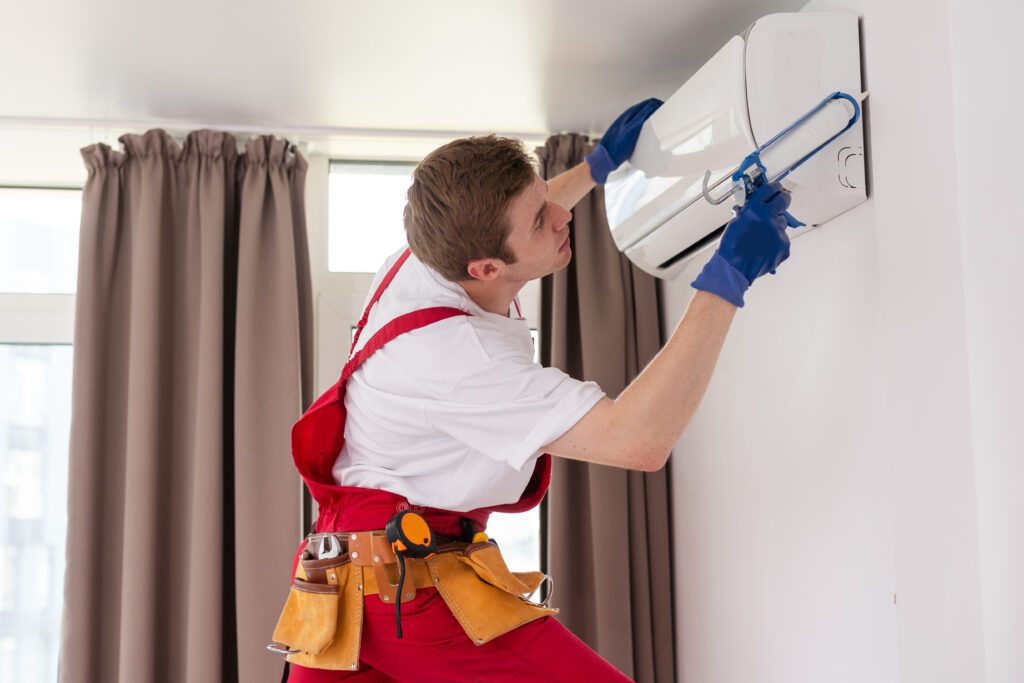
Before diving into the cleaning process, it’s important to gather the necessary supplies. You will need a soft brush or vacuum cleaner, a hose with a sprayer attachment, mild detergent or coil cleaner, a soft cloth or sponge, and gloves for protection.
Spring cleaning your air conditioner is not just about removing visible dirt and debris; it’s also about ensuring the efficiency and longevity of your unit. By maintaining a clean air conditioner, you can improve its performance and reduce energy consumption, ultimately saving you money on utility bills.
Gathering the Necessary Cleaning Supplies
When gathering supplies, it’s important to choose cleaning products specifically designed for air conditioners. Using the wrong products can damage the coils or other sensitive components. If you’re unsure which products to use, consult the manufacturer’s instructions or seek professional advice.
Investing in high-quality cleaning products may seem like a small detail, but it can make a significant difference in the effectiveness of your cleaning routine. Opting for products recommended by professionals can ensure that your air conditioner is not only clean but also well-maintained.
Safety Precautions to Consider Before Starting
Prior to cleaning your air conditioner, it’s crucial to ensure your safety. Start by turning off the power to the unit. This can be done by switching off the corresponding circuit breakers. Additionally, wear protective gloves to avoid injury and protect yourself from potentially harmful substances or sharp edges. Safety should always be a priority when performing any maintenance tasks.
Remember, proper maintenance of your air conditioner can extend its lifespan and prevent costly repairs down the line. Taking the time to clean and care for your unit now can pay off in the long run, keeping you cool and comfortable for years to come.
Step-by-Step Guide to Cleaning Your Air Conditioner
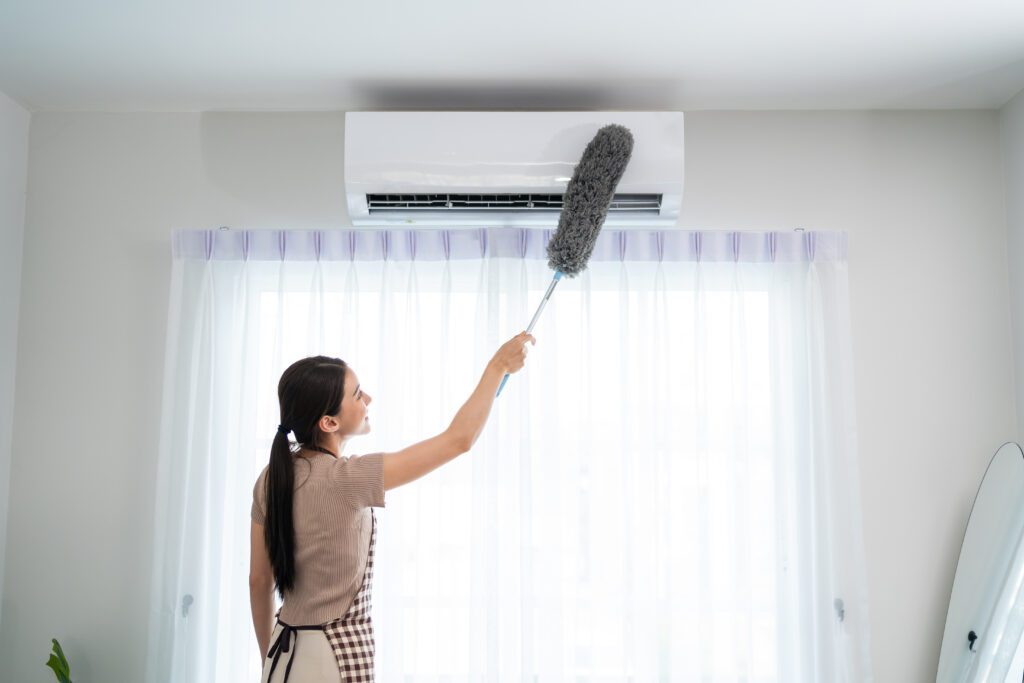
Cleaning the Exterior Unit
Begin the cleaning process by inspecting the exterior unit for any visible debris or vegetation. Remove any leaves, twigs, or grass clippings that may have accumulated around the unit. It is important to maintain the recommended clearances for proper airflow and ventilation.
Did you know that debris and vegetation can hinder the performance of your air conditioner? When the exterior unit is surrounded by leaves or grass clippings, it restricts the airflow, causing your AC to work harder and less efficiently. By keeping the area around the unit clean and clear, you can ensure optimal performance and energy efficiency.
Next, gently clean the exterior unit using a soft brush or vacuum cleaner. Remove loose dirt and debris from the fins, but be careful not to bend or damage them in the process.
Those fins on the exterior unit play a crucial role in the heat transfer process. They help dissipate heat from the refrigerant, allowing your air conditioner to cool the air effectively. By keeping the fins clean and free from dirt and debris, you can ensure that your AC operates at its best.
If the fins are significantly dirty, you may need to use a hose with a sprayer attachment to remove stubborn dirt. However, be cautious when using water near electrical components. Avoid spraying water directly into the unit, and ensure that the power is turned off.
Water and electricity don’t mix well, so it’s important to exercise caution when cleaning your air conditioner. If you need to use water to clean the fins, make sure to turn off the power and avoid spraying water directly into the unit. This will prevent any potential electrical hazards and keep you safe.
Cleaning the Interior Unit
To clean the interior unit, start by removing the filter. Depending on the type of filter, you can either wash it with mild detergent and water or replace it with a new one. Clean or replace the filter regularly to maintain optimal air quality and system efficiency.
The filter in your air conditioner is responsible for trapping dust, pollen, and other airborne particles, ensuring that the air you breathe is clean and healthy. Over time, the filter can become clogged and dirty, reducing its effectiveness. By cleaning or replacing the filter regularly, you can improve the air quality in your home and keep your AC running smoothly.
Gently brush or vacuum the evaporator coil to remove any dust or dirt. Avoid using excessive force, as the coil is delicate and can easily bend or break. If necessary, use a soft cloth or sponge with a mild detergent or coil cleaner to remove stubborn grime.
The evaporator coil is where the magic happens. It absorbs heat from the air, cooling it down before it gets circulated back into your home. However, over time, the coil can accumulate dust and dirt, reducing its efficiency. By gently cleaning the coil, you can ensure that your air conditioner works optimally, providing you with the cool and comfortable air you desire.
Lastly, clean the condensate drain line to prevent clogs. You can use a mixture of water and bleach or a specialized condensate line cleaning agent. Pour the solution into the drain line to remove any algae or debris that may be obstructing the flow of water. Regularly cleaning the condensate drain line prevents water leakage and potential water damage.
The condensate drain line is responsible for removing the excess moisture that is produced during the cooling process. Over time, this drain line can become clogged with algae, dirt, or other debris, leading to water leakage and potential water damage. By regularly cleaning the drain line, you can prevent these issues and ensure that your air conditioner operates smoothly.
Maintaining Your Air Conditioner Post-Spring Cleaning
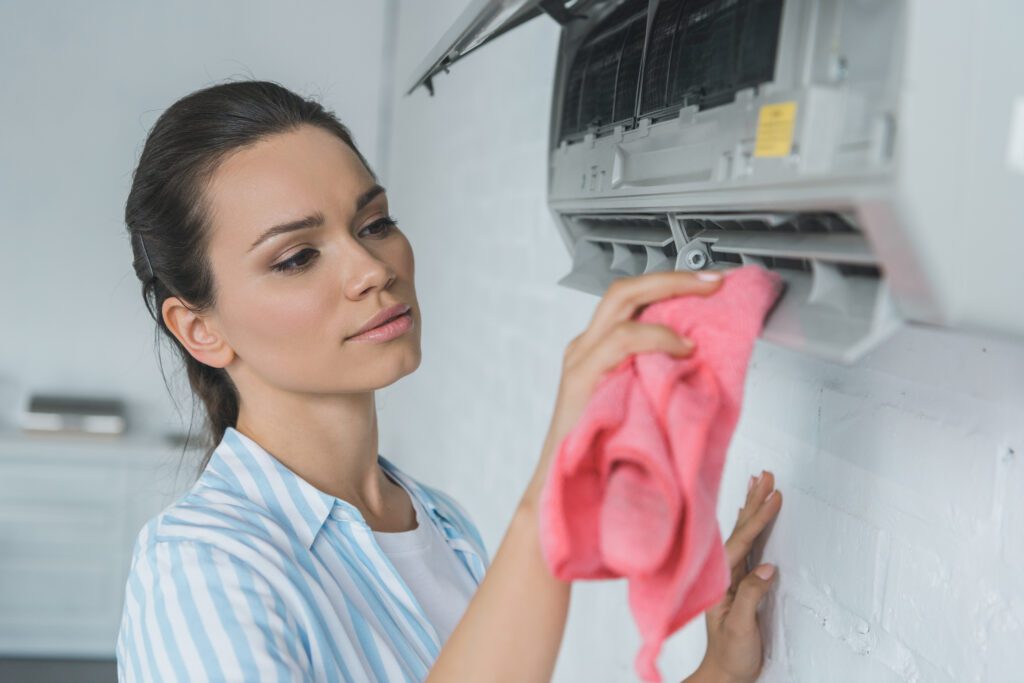
As the temperatures rise and the summer months approach, it’s crucial to keep your air conditioner in top condition post-spring cleaning. In addition to the standard maintenance tasks, there are a few additional steps you can take to ensure your AC unit operates efficiently throughout the season.
One important aspect to consider is the condenser coils. Over time, these coils can accumulate dirt and debris, reducing the unit’s ability to cool the air effectively. To prevent this, gently clean the coils using a soft brush or cloth. Be sure to turn off the power to the unit before attempting any cleaning to avoid any accidents.
Routine Checks and Minor Cleanups
After completing the spring cleaning process, it’s important to perform routine checks and minor cleanups throughout the season. Regularly inspect the unit for any signs of damage, leaks, or unusual noises. Additionally, check the filter and clean or replace it as necessary.
Keep the area around the exterior unit clear of debris and vegetation. Trim any overhanging branches or shrubs that may hinder proper airflow. Regularly cleaning the exterior unit and ensuring unrestricted airflow will help maintain optimal performance and reduce the risk of breakdowns.
Another area to pay attention to is the ductwork. Leaks or blockages in the ducts can significantly reduce the efficiency of your air conditioner. Inspect the ducts for any signs of damage and seal any leaks with duct mastic or foil tape. Additionally, consider scheduling a professional duct cleaning every few years to remove built-up dust and debris.
When to Call a Professional for Maintenance
While regular maintenance can be performed by homeowners, some tasks are best left to professionals. If you’re unsure about any aspect of your air conditioner’s maintenance or if you encounter complex issues, it’s recommended to seek assistance from a qualified HVAC technician.
Professional maintenance ensures that all components are thoroughly inspected, cleaned, and adjusted if necessary. This helps identify potential problems early on and prevents major breakdowns or costly repairs in the future.
Common Mistakes to Avoid During Air Conditioner Cleaning
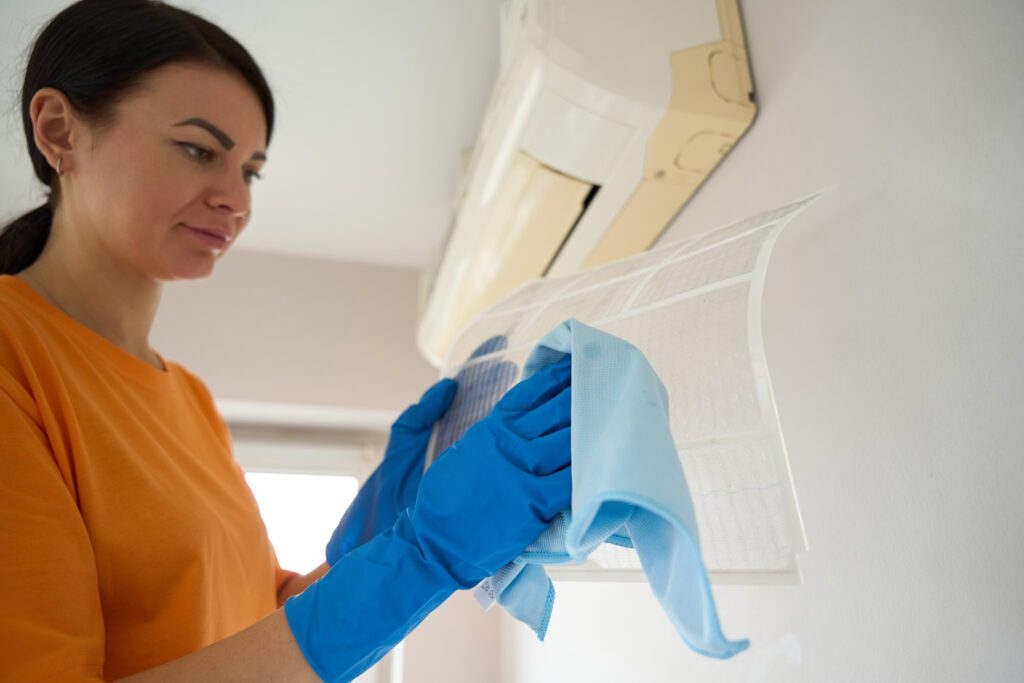
Using the Wrong Cleaning Products
One common mistake homeowners make is using the wrong cleaning products when cleaning their air conditioners. Using harsh chemicals or abrasive materials can cause damage to the coils, fins, or other sensitive components. It’s important to follow the manufacturer’s recommendations and use appropriate cleaning products specifically designed for air conditioners.
Neglecting Certain Parts of the Air Conditioner
Another mistake to avoid is neglecting certain parts of the air conditioner during the cleaning process. It’s crucial to clean both the exterior and interior units, including the condenser coils, air filters, and condensate drain line. Neglecting any of these components can lead to restricted airflow, decreased efficiency, and potential system damage.
Regular maintenance should be comprehensive and cover all essential components of your air conditioner to ensure optimal performance and longevity.
When it comes to cleaning the exterior unit, it’s important to pay attention to the fins. Over time, these fins can become clogged with dirt, dust, and debris, hindering the airflow and reducing the efficiency of your air conditioner. To clean the fins, you can use a soft brush or a vacuum cleaner with a brush attachment. Gently brush away the dirt and debris, making sure not to bend or damage the fins in the process.
Additionally, don’t forget to clean the condensate drain line. This line is responsible for removing the excess moisture from your air conditioner. Over time, it can become clogged with algae, mold, and other debris, leading to water leaks and potential damage to your unit. To clean the condensate drain line, you can use a mixture of bleach and water. Pour the solution into the drain line and let it sit for a few minutes before flushing it out with water.
In conclusion, regular spring cleaning and maintenance are essential for the proper functioning and longevity of your air conditioner. By understanding the importance of maintenance, preparing your unit for cleaning, following the step-by-step guide, and conducting post-cleaning maintenance, you can ensure that your air conditioner operates efficiently and keeps you cool throughout the hot summer months. Avoiding common cleaning mistakes and seeking professional help when needed will further contribute to the longevity and efficiency of your cooling system. With these tips, you can turn your air conditioner into a reliable and efficient cooling companion.

